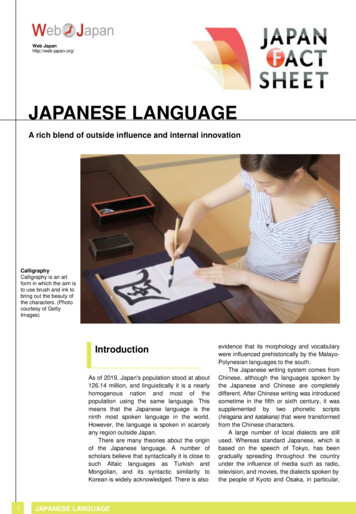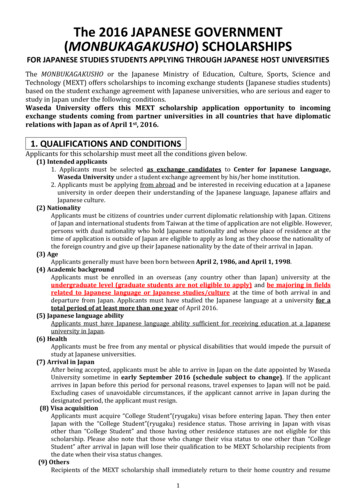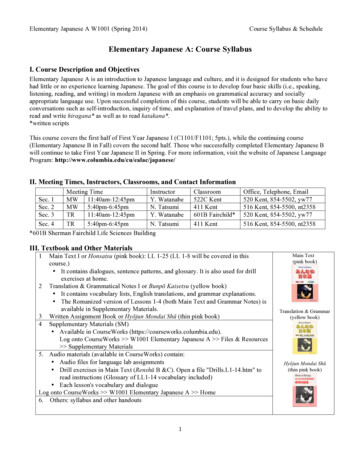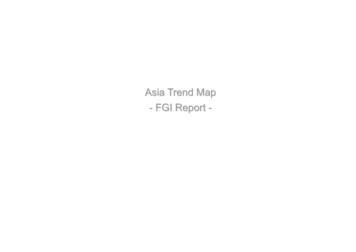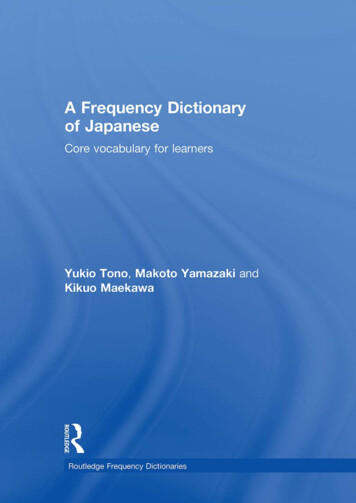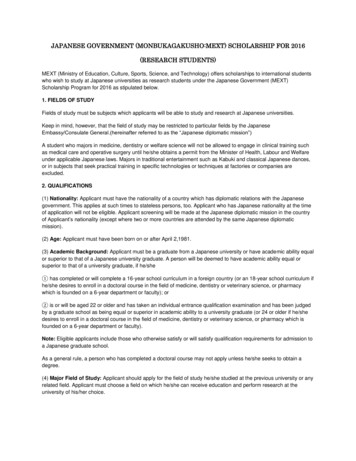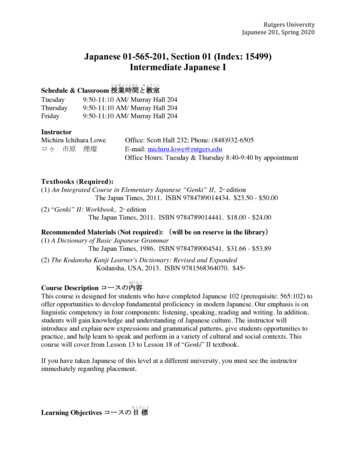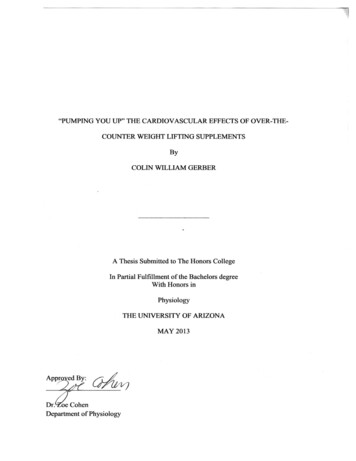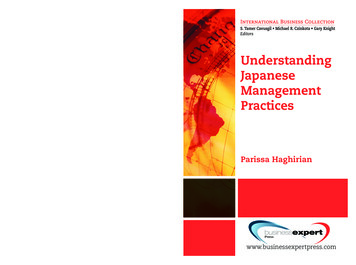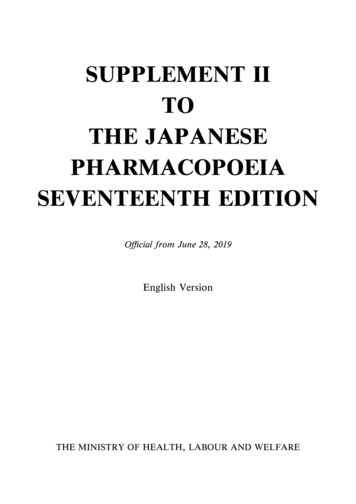
Transcription
SUPPLEMENT IITOTHE JAPANESEPHARMACOPOEIASEVENTEENTH EDITIONO‹cial from June 28, 2019English VersionTHE MINISTRY OF HEALTH, LABOUR AND WELFARE
Notice: This English Version of the Japanese Pharmacopoeia is publishedfor the convenience of users unfamiliar with the Japanese language. Whenand if any discrepancy arises between the Japanese original and its Englishtranslation, the former is authentic.Printed in Japan
The Ministry of Health, Labour andWelfare Ministerial Notification No. 49Pursuant to Paragraph 1, Article 41 of Act on Securing Quality, Efficacy andSafety of Products Including Pharmaceuticals and Medical Devices (Act No. 145,1960), this notification stated that a part of the Japanese Pharmacopoeia was revisedas follows*.NEMOTO TakumiThe Minister of Health, Labour and WelfareJune 28, 2019A part of the Japanese Pharmacopoeia (Ministerial Notification No. 64, 2016) wasrevised as follows*.(The text referred to by the term as follows'' are omitted here. All of the revisedJapanese Pharmacopoeia in accordance with this notification (hereinafter referred toas new Pharmacopoeia'' in Supplement 2) are made available for public exhibitionat the Pharmaceutical Evaluation Division, Pharmaceutical Safety and Environmental Health Bureau, Ministry of Health, Labour and Welfare, at each Regional Bureauof Health and Welfare, and at each Prefectural Office in Japan).Supplementary Provisions(Effective Date)Article 1 This Notification is applied from June 28, 2019.(Transitional measures)Article 2 In the case of drugs which are listed in the Japanese Pharmacopoeia(hereinafter referred to as previous Pharmacopoeia'') [limited to those listed innew Pharmacopoeia] and drugs which have been approved as of June 28, 2019 asprescribed under Paragraph 1, Article 14 of Act on Securing Quality, Efficacy andSafety of Products Including Pharmaceuticals and Medical Devices [includingdrugs the Minister of Health, Labour and Welfare specifies (the Ministry of Healthand Welfare Ministerial Notification No. 104, 1994) as of June 27, 2019 as thoseexempted from marketing approval pursuant to Paragraph 1, Article 14 of thesame law (hereinafter referred to as drugs exempted from approval'')], the Standards established in the previous Pharmacopoeia (limited to part of the Standardsfor the drugs concerned) may be accepted to conform to the Standards establishedin the new Pharmacopoeia before and on December 31, 2020. In the case of drugswhich are listed in the new Pharmacopoeia (excluding those listed in the previousPharmacopoeia) and drugs which have been approved as of June 28, 2019 asprescribed under the Paragraph 1, Article 14 of the same law (including those exempted from approval), they may be accepted as those being not listed in the newPharmacopoeia before and on December 31, 2020.(Partial revision of Products Delivery Rules of National Institute of Infectious Diseases)Article 3 Omitted.*The term as follows'' here indicates the content of Supplement II to the Japanese PharmacopoeiaSeventeenth Edition from General Notice to Ultraviolet-visible Reference Spectra (pp. 2877 – 2991).
CONTENTSPreface . iSupplement II to The Japanese Pharmacopoeia,Seventeenth Edition . 2877–2991General Notices . 2877General Rules for Preparations . 2879General Tests, Processes and Apparatus . 28812.01 Liquid Chromatography . 28812.26 Raman Spectroscopy. 28822.46 Residual Solvents . 28842.51 Conductivity Measurement. 28912.66 Elemental Impurities—Procedures . 28936.16 Rheological Measurements for Semisolid Preparations . 28966.17 Insoluble Particulate Matter Test forTherapeutic Protein Injections . 29009.01 Reference Standards . 29019.21 Standard Solutions for VolumetricAnalysis . 29019.22 Standard Solutions . 29019.41 Reagents, Test Solutions. 29019.42 Solid Supports/Column Packingsfor Chromatography. 2908O‹cial Monographs . 2909Crude Drugs and Related Drugs. 2973Infrared Reference Spectra . 2985–2987Ultraviolet-visible Reference Spectra . 2989–2991General InformationG1 Physics and ChemistryControl of Elemental Impurities inDrug Products.G3 Biotechnological/Biological ProductsHost Cell Protein Assay .Total Protein Assay.G4 MicroorganismsMedia Fill Test (Process Simulation) .Microbiological Environmental Monitoring Methods of Processing Areasfor Sterile Pharmaceutical Products .Parametric Release of Terminally Sterilized Pharmaceutical Products .G5 Crude DrugsPurity Tests on Crude Drugs usingGenetic Information .On the Scientiˆc Names of Crude Drugslisted in the JP .G8 WaterQuality Control of Water for Pharmaceutical Use .G10 OthersBasic Concepts for Quality Assuranceof Drug Substances and Drug Products .Concept on Impurities in Chemicallysynthesized Drug Substances andDrug Products.Glossary for Quality by Design (QbD),Quality Risk Management (QRM)and Pharmaceutical Quality System(PQS) .International Harmonization Implemented in the Japanese Pharmacopoeia Seventeenth Edition 014Index. 3019Index in Latin Name. 3039Index in Japanese. 3041
PREFACEThe 17th Edition of the Japanese Pharmacopoeia(JP) was promulgated by Ministerial NotificationNo.64 of the Ministry of Health, Labour and Welfare(MHLW) on March 7, 2016.In July 2016, the Committee on JP established thebasic principles for the preparation of the JP 18th Edition, setting out the roles and characteristics of the JP,the definite measures for the revision, and the date ofthe revision.It was agreed that the JP should provide an officialstandard, being required to assure the quality of medicines in Japan in response to the progress of scienceand technology and medical demands at the time. Itshould define the standards for specifications, as wellas the methods of testing to assure overall quality ofall drugs in principle, and it should have a role inclarifying the criteria for quality assurance of drugsthat are recognized to be essential for public healthand medical treatment.The JP has been prepared with the aid of theknowledge and experience of many professionals inthe pharmaceutical field. Therefore, the JP shouldhave the characteristics of an official standard, whichmight be widely used by all parties concerned, and itshould play an appropriate role of providing information and understanding about the quality of drugs tothe public. Moreover, as a pharmaceutical qualitystandard, it should contribute promoting and maintaining of advancedness as well as international consistency and harmonization of technical requirementsin the international community.At the Committee, the five basic principles of JP,which we refer to as the five pillars'', were established as follows: 1) Including all drugs which are important from the viewpoint of health care and medicaltreatment; 2) Making qualitative improvement by introducing the latest science and technology; 3) Furtherpromoting internationalization in response to globalization of drug market; 4) Making prompt partial revision as necessary and facilitating smooth administrative operation; and 5) Ensuring transparency regarding the revision, and disseminating the JP to the public. It was agreed that the Committee on JP shouldmake efforts, on the basis of these principles, to ensure that the JP is used more effectively in the fields ofhealth care and medical treatment by taking appropriate measurements, including getting the understandingand cooperation of other parties concerned.It was also agreed that JP articles should coverdrugs, which are important from the viewpoint ofhealth care and medical treatment, clinical performance or merits and frequency of use, as soon as possible after they reach the market.The target date for the publication of JP 18th Edition (the Japanese edition) was set as April 2021.JP drafts are discussed in the following committeesthat were established in the Pharmaceuticals and Medical Devices Agency: Expert Committee; Sub-expertCommittee; Sub-committee on Manufacturing Process-related Matters; Committee on Chemicals; Committee on Antibiotics; Committee on Biologicals;Committee on Crude Drugs; Committee on Pharmaceutical Excipients; Committee on Physico-Chemical Methods; Committee on Drug Formulation; Committee on Physical Methods; Committee on BiologicalMethods; Committee on Nomenclature for Pharmaceuticals; Committee on International Harmonization; and Committee on Reference Standards. Furthermore, working groups are established under theExpert Committee, Committee on Pharmaceutical Excipients, Committee on Physico-Chemical Methodsand Committee on Drug Formulation.The committees initiated deliberations on several revisions.Draft revisions covering subjects in General Notices, General Rules for Preparations, General Tests,Monographs, Ultraviolet-visible Reference Spectraand Infrared Reference Spectra for which discussionswere finished between April 2017 and November 2018,were prepared for a supplement to the JP 17.Numbers of discussions in the committees to prepare the supplement drafts were as follows: ExpertCommittee (11, including a working group); Sub-committee on Manufacturing Process-related Matters (6),Committee on Chemicals (18), Committee on Antibiotics (3); Committee on Biologicals (7); Committeeon Crude Drugs (15); Committee on PharmaceuticalExcipients (10); Committee on Physico-ChemicalMethods (11, including a working group); Committeeon Drug Formulation (19, including working groups);Committee on Physical Methods (7); Committee onBiological Methods (6); Committee on Nomenclaturefor Pharmaceuticals (5); Committee on InternationalHarmonization (4).It should be noted that in the preparation of thedrafts for the supplement, generous cooperation wasi
iiPrefacegiven by the Pharmaceutical Technology Committeeof the Kansai Pharmaceutical Industries Association,the Pharmacopeia and CMC Committee of the Pharmaceutical Manufacturers' Association of Tokyo, theTokyo Crude Drugs Association, the InternationalPharmaceutical Excipients Council Japan, the HomeMedicine Association of Japan, the Japan KampoMedicines Manufacturers Association, the JapanFlavor and Fragrance Materials Association, theJapan Medical Plants Federation, the Japan Pharmaceutical Manufacturers Association, the Federationof Pharmaceutical Manufacturers’ Association ofJapan, the Parenteral Drug Association Japan Chapter, the Japan Reagent Association, the Japan Oilseeds Processors Association, the Japan AnalyticalInstruments Manufacturers' Association, and the Asian Society of Innovative Packaging Technology.The draft revisions were examined by the Committee on JP in January 2019, followed by the Pharmaceutical Affairs and Food Sanitation Council(PAFSC) in March 2019, and then submitted to theMinister of Health, Labour and Welfare. In the Committee on JP, Mitsuru Hashida took the role of chairman from January 2011 to June 2019.In consequence of this revision, the JP 17th Editioncarries 2008 articles, owing to the addition of 34 articles and the deletion of 3 articles.The principles of description and the salient pointsof the revision in this volume are as follows:1. The Supplement II to JP 17th Edition comprises the following items, in order: Notification ofMHLW; Contents; Preface; General Notices, GeneralRules for Preparations; General Tests, Processes andApparatus; Official Monographs; then followed byInfrared Reference Spectra and Ultraviolet-visibleReference Spectra; General Information; and as anappendix a Cumulative Index containing references tothe main volume, the Supplement I and the Supplement II.2. The articles in Official Monographs, InfraredReference Spectra and Ultraviolet-visible ReferenceSpectra are respectively placed in alphabetical order inprinciple.3. The following items in each monograph are putin the order shown below, except that unnecessaryitems are omitted depending on the nature of the drug:(1) English title(2) Commonly used name(s)(3) Latin title (only for crude drugs)(4) Title in JapaneseSupplement II, JP XVII(5) Structural formula or empirical formula(6) Molecular formula and molecular mass(7) Chemical name(8) Chemical Abstracts Service (CAS) RegistryNumber(9) Origin(10) Limits of the content of the ingredient(s) and/orthe unit of potency(11) Labeling requirements(12) Method of preparation(13) Manufacture(14) Description(15) Identification tests(16) Specific physical and/or chemical values(17) Purity tests(18) Potential adulteration(19) Loss on drying or Ignition, or Water(20) Residue on ignition, Total ash or Acid-insolubleash(21) Tests being required for pharmaceutical preparations(22) Other special tests(23) Assay(24) Containers and storage(25) Shelf life(26) Others4. In each monograph, the following physical andchemical values representing the properties and quality of the drug are given in the order indicated below,except that unnecessary items are omitted dependingon the nature of drug:(1) Alcohol number(2) Absorbance(3) Congealing point(4) Refractive index(5) Osmolar ratio(6) Optical rotation(7) Constituent amino acids(8) Viscosity(9) pH(10) Content ratio of the active ingredients(11) Specific gravity(12) Boiling point(13) Melting point(14) Acid value(15) Saponification value(16) Ester value(17) Hydroxyl value(18) Iodine value5. Identification tests comprise the followingitems, which are generally put in the order given
Supplement II, JP XVIIbelow:(1) Coloration reactions(2) Precipitation reactions(3) Decomposition reactions(4) Derivatives(5) Infrared and/or ultraviolet-visible absorptionspectrometry(6) Nuclear magnetic resonance spectrometry(7) Chromatography(8) Special reactions(9) Cations(10) Anions6. Purity tests comprise the following items, whichare generally put in the order given below, except thatunnecessary items are omitted depending on the nature of drug:(1) Color(2) Odor(3) Clarity and/or color of solution(4) Acidity or alkalinity(5) Acidity(6) Alkalinity(7) Chloride(8) Sulfate(9) Sulfite(10) Nitrate(11) Nitrite(12) Carbonate(13) Bromide(14) Iodide(15) Soluble halide(16) Thiocyanate(17) Selenium(18) Cationic salts(19) Ammonium(20) Heavy metals(21) Iron(22) Manganese(23) Chromium(24) Bismuth(25) Tin(26) Aluminum(27) Zinc(28) Cadmium(29) Mercury(30) Copper(31) Lead(32) Silver(33) Alkaline earth metals(34) Arsenic(35) Free phosphoric acid(36) Foreign elated substancesIsomerOptical isomerPolymerResidual solventOther impuritiesResidue on evaporationReadily carbonizable substances7. The following paragraphs of General Noticeswere revised:(1) Paragraph 5: Shelf life'' in the monographson preparations were removed from the standards for conformity, because that the stabilityof a pharmaceutical preparation differs depending on the formulation, type of the container and packaging and the control of thestorage temperature, etc.(2) Paragraph 13: As the cases for drug approvalwith the quality control using the real timerelease testing (RTRT) have been accumulated,the rules of RTRT for drug release were addedwhen RTRT is adopted as an alternativemethod.(3) Paragraph 46: Expiration Date'' in OfficialMonograph was changed to Shelf life'' in theSupplement I to JP 17th Edition. In this revision, the rule for expression of expiration datewas removed.8. The following paragraphs were newly added tothe General Rules for Preparations:(1) The following item was newly added to the [3]Monographs for Preparations basing on thediscussion about needs of this item followingrelease of the guideline for developingliposomal formulations:3-1-4. Liposome Injections9. The General Rules for Preparations was revisedas follows in general:(1) [3] Monographs for Preparations: 3-1. Injections'': the definition of Liposome Injections'' introduced in this revision was newlyadded, and 6.17 Insoluble Particulate MatterTest for Therapeutic Protein Injections''added to General Tests in this revision wasreferred and prescribed.10. The following items were newly added toGeneral Tests, Processes and Apparatus:(1) 2.26 Raman Spectroscopy(2) 2.66 Elemental Impurities-Procedures
Prefaceiv(3)(4)6.16 Rheological Measurements for Semisolid Preparations6.17 Insoluble Particulate Matter Test forTherapeutic Protein Injections11. The following items in General Tests, Processes and Apparatus were revised:(1) 2.01 Liquid Chromatography(2) 2.46 Residual Solvents(3) 2.51 Conductivity Measurement12. The following Reference Standards were newly added:Bromfenac Sodium RSL-Carnosine RSDoripenem RSGatifloxacin RSHydroxyethylcellulose RS for IdentificationLanoconazole RSMicrocrystalline Cellulose RS for IdentificationResidual Solvents Class 2C RSSitagliptin Phosphate RSSitagliptin Phosphate RS for System Suitability13. The following Reference Standards were removed from 9.01 (2) The reference standards whichare prepared by National Institute of Infectious Diseases.'' and added to 9.01 (1) The reference standards which are prepared by those who have beenregistered to prepare them by the Minister of Health,Labour and Welfare, according to the Ministerial ordinance established by the Minister separately'':Ampicillin RSAzithromycin RSCefazolin RSCefmetazole RSFradiomycin Sulfate RSMeropenem RS14. The following substances were newly added tothe Official Monographs:Bromfenac Sodium HydrateBromfenac Sodium Ophthalmic SolutionCefalotin Sodium for InjectionCefixime Fine GranulesClarithromycin for SyrupDiclofenac Sodium SuppositoriesDoripenem HydrateDoripenem for InjectionEthylcelluloseFelodipineFelodipine TabletsGatifloxacin HydrateSupplement II, JP XVIIGatifloxacin Ophthalmic SolutionGentamicin Sulfate InjectionGentamicin Sulfate OintmentHydroxyethylcelluloseIrinotecan Hydrochloride HydrateLanoconazoleLanoconazole CreamLanoconazole Cutaneous SolutionLanoconazole OintmentMinocycline Hydrochloride GranulesNortriptyline Hydrochloride TabletsPolaprezincPolaprezinc GranulesRitodrine Hydrochloride InjectionSitagliptin Phosphate HydrateSitagliptin Phosphate TabletsSodium Valproate Extended-release Tablets ASodium Valproate Extended-release Tablets BTelmisartan and Hydrochlorothiazide TabletsValsartan and Hydrochlorothiazide TabletsVerapamil Hydrochloride InjectionGoshuyuto Extract15. The following monographs were revised:Amphotericin B TabletsBeclometasone DipropionateBetamethasone DipropionateAnhydrous Dibasic Calcium PhosphateMicrocrystalline CelluloseChloramphenicolChlorpromazine HydrochlorideCholesterolCloperastine HydrochlorideDehydrocholic AcidPurified Dehydrocholic AcidEpirubicin oneHydrocortisone AcetateHydrocortisone and Diphenhydramine ne HydrochlorideImipramine Hydrochloride TabletsIsomalt ioglitazone Hydrochloride and GlimepirideTabletsSaccharin
Supplement II, JP XVIISaccharin Sodium HydrateLight Anhydrous Silicic AcidSodium FusidateTeicoplaninTestosterone EnanthateTipepidine Hibenzate TabletsTriamcinolone AcetonideUrsodeoxycholic AcidAmomum SeedArtemisia Capillaris FlowerBelladonna RootBitter TinctureBofutsushosan ExtractBoiogito ExtractCalumbaPowdered CalumbaCassia SeedChrysanthemum FlowerEucalyptus OilGastrodia TuberGlycyrrhiza ExtractCrude Glycyrrhiza ExtractHochuekkito ExtractJapanese Angelica RootPowdered Japanese Angelica RootJuzentaihoto ExtractKakkontokasenkyushin'i ExtractKamikihito ExtractKamishoyosan ExtractLithospermum RootLycium BarkNux VomicaOriental BezoarOtsujito ExtractPlatycodon RootPowdered Platycodon RootPlatycodon FluidextractPolygala RootPowdered Polygala RootSafflowerSaposhnikovia Root and RhizomeScopolia RhizomeSinomenium Stem and RhizomeSwertia HerbPowdered Swertia HerbSwertia and Sodium Bicarbonate PowderToad CakeTokishakuyakusan ExtractYokukansan Extract16. The following monographs were deleted:Adsorbed Habu-venom ToxoidFreeze-dried Tetanus Antitoxin, EquinePrefacevCompound Vitamin B Powder17. The following articles were newly added to Ultraviolet-visible Reference Spectra:Bromfenac Sodium HydrateDoripenem HydrateFelodipineGatifloxacin HydrateIrinotecan Hydrochloride HydrateLanoconazoleSitagliptin Phosphate Hydrate18. The following articles were newly added to Infrared Reference Spectra:Bromfenac Sodium HydrateDoripenem HydrateEthylcelluloseFelodipineGatifloxacin HydrateIrinotecan Hydrochloride HydrateLanoconazolePolaprezincSitagliptin Phosphate HydrateThose who were engaged in the preparation of theSupplement II to JP 17 are as followsABE YasuhiroAITA YouheiAKAO KenichiARATO TeruyoARIMOTO KeikoARUGA NaokiASAMA HiroshiASHIZAWA KazuhideASO ShinichiroASO YukioDEMIZU YosukeEMURA MakotoFUCHINO HiroyukiFUJII MakikoFUKAZAWA HidesukeFUKUDA ShinjiFUKUHARA KiyoshiFURUICHI HarumiFURUKAWA HiromitsuGODA YukihiroGOTO TakashiGOTO TamamiHAISHIMA YujiHAKAMATA HidekiHAKAMATSUKA TakashiHANADA KentaroHANAJIRI Ruri
viPrefaceHARAZONO AkiraHASHIDA Mitsuru*HASHII NoritakaHATANO RikaHAYASHI AiHAYASHI AkiraHAYASHI YoshinoriHIGANO TaroHIGUCHI YasuhikoHIYAMA YukioHORI MasatoshiHYUGA MasashiICHINOSE KojiIIMORI JumpeiIKARASHI YoshiakiIKEDO ShingoIMAMOTO TsuyoshiISHIDA MasatoISHII AkikoITAI ShigeruITO MichihoITO RyoichiITO YujiIZUTANI YusukeIZUTSU KenichiKAMMOTO ToshihiroKATAYAMA HirohitoKATO KumikoKATORI NorikoKAWAHARA NobuoKAWAI TamotsuKAWAMATA TomomiKAWANISHI ToruKAWARASAKI YoshihikoKAWASAKI Nana**KIJIMA KeijiKIKUCHI YutakaKIKUCHI YuuichiKISHIMOTO YasuhiroKITAJIMA AkihitoKITTAKA AtsushiKIUCHI FumiyukiKOBAYASHI TakashiKOCHI RikaKOHAMA AiKOIDE TatsuoKOJIMA TakashiKOKUBO HiroyasuKOMATSU KatsukoKONDA ToshifumiKONDO SeizoKUBOSAKI AtsutakaKUBOTA KiyoshiSupplement II, JP XVIIKUMASAKA KenichiKURIHARA MasaakiKUSUNOKI HidekiMAKIURA ToshinobuMARUYAMA TakuroMASADA SayakaMATSUMOTO KazuhiroMATSUMOTO MakotoMATSUMURA HajimeMIKAMI EiichiMISAWA TakashiMITSUHASHI TakaoMIYATA NaokiMIYAZAKI TamakiMIZUNO TakeshiMORI MitsuoMORIBE KunikazuMORIMOTO SeikiMORIMOTO TakashiMORISAKI TakahitoMORIYASU TakakoMUROI MasashiNAKA NobuyukiNAKAGAWA HidehikoNAKAGAWA ShinsakuNAKAGAWA YukariNAKAKO MayumiNAKANO TatsuyaNANAURA MitsuoNASU MasaoNISHIKAWA NoriakiNOGUCHI ShujiOBA SumiakiOBARA Saka áeOGAWA ToruOGURA YasumitsuOGURI KazukiOHGAMI YasutakaOKUBO TsuneoOKUDA AkihiroOKUDA HaruhiroOMURA KoichiONO MakotoONODA HiroshiOSUMI YukoOTSUKA MasamiOUCHI TadashiSAITO HideyukiSAKAI EijiSAKAMOTO TomoakiSANTA TomofumiSASAKI HiroshiSASAKI Kunio
Supplement II, JP XVIISASAKI SatoshiSASAKI YukoSATO KojiSATO KyokoSATO NorihisaSEGAWA MasashiSEKIGAWA FujioSEKIGUCHI MichikoSHIBATA HirokoSHIBAYAMA KeigoSHIBAZAKI KeikoSHIDA ShizukaSHIMADA YasuoSHIMAZAWA RumikoSHIMIZU MasaroSHIMOKAWA SayuriSHINOHARA KatsuakiSHIRATORI MakotoSHIROTA OsamuSHODA TakujiSUDO HirotakaSUDO KeiichiSUGIMOTO NaokiSUZUKI MikioSUZUKI NoriyukiSUZUKI RyojiSUZUKI ShigeoSUZUKI TomoyukiTADA MinoruTADAKI ShinichiTAKANO AkihitoTAKAO MasakiTAKEDA OsamiTAKEDA TomokoTAKEUCHI HirohumiTAKEUCHI HisashiTANABE ToyoshigeTANAKA MasakazuTANAKA TomohideTANAKA SatoshiTANIMOTO TsuyoshiTERABAYASHI SusumuTERADA KatsuhideTERAOKA ReikoTOKUMOTO HirokoTOKUNAGA HiroshiTOKUOKA ShogoTOMIOKA KiyoshiTOYODA TaichiTSUDA ShigekiUCHIYAMA NahokoUETAKE AtsuhiroWATANABE TakumiPrefaceYAMADA RumikoYAMAGUCHI TetsujiYAMAJI HirokiYAMAMOTO KeijiYAMASHITA ChikamasaYASUHARA MasatoYOMOTA ChikakoYONEDA SachiyoYONEMOCHI EtsuoYOSHIDA HiroyukiYOSHIDA Naoya*: Chairman, the Committee on JP**: Acting Chairman, the Committee on JPvii
Supplement II toThe JapanesePharmacopoeiaSeventeenth Edition
GENERAL NOTICESChange the paragraphs 5, 13 and 46 as follows:5. The JP Drugs are to be tested according to the provisions given in the pertinent monographs, General Notices,General Rules for Crude Drugs, General Rules forPreparations, and General Tests for their conformity to theJapanese Pharmacopoeia. However, the headings of Description'' and in addition Containers and storage''and Shelf life'' in the monographs on preparations aregiven for information, and should not be taken as indicating standards for conformity. Nevertheless, Containersunder Containers and storage'' in the monograph onpreparations containing crude drugs as main activeingredients are the standards for conformity.13. When an assurance that a product is of the JP Drugquality is obtained consistently from data derived from themanufacturing process validation studies, and from therecords of appropriate manufacturing process control andof the test results of the quality control, the performance ofsome test items in the monograph at release on a productmay be omitted as occasion demands. Moreover, the qualityevaluation of ˆnal products (drug substances and drugproducts) based on in-process data including in-process testing results and monitoring data on process parameters canreplace speciˆcations and test methods in the monograph orperforming the test methods, if appropriate.46. For the JP Drugs, the contents or potency in terms ofunits of the active ingredient(s) in the monographs have tobe shown on the immediate container or wrapping of them.The JP Drugs are to be tested according to the provisions given in the pertinent monographs, General Notices, General Rules for Crude Drugs,General Rules for Preparations, and General Tests for their conformity to the Japanese Pharmacopoeia. (See the General Notices 5.)2877
GENERAL RULESFOR PREPARATIONS[3]Monographs for PreparationsChange the following paragraphs:3. Preparations for Injection3-1. Injections(1) Injections are sterile preparations to be administereddirectly into the body through skin, muscle or blood vessel,usually in form of a solution, a suspension or an emulsionof active substance(s), or of a solid that contains active substance(s) to be dissolved or suspended before use.Parenteral Infusions, Implants/Pellets, ProlongedRelease Injections and Liposome Injections are included inthis category.(14) Unless otherwise speciˆed, Injections and vehiclesattached to preparations meet the requirements of InsolubleParticulate Matter Test for Injections 6.07 or InsolubleParticulate Matter Test for Therapeutic Protein Injections 6.17 .Add the following next to 3-1-3. ProlongedRelease Injections:3-1-4. Liposome Injections(1) Liposome Injections are injections to be used for intravenous administration, which are intended for improvement of in vivo stability, delivery to a target region and control of release, of active substance(s).(2) Liposome Injections are usually prepared by usingamphipathic lipid, etc. to make aqueous injections orfreeze-dried injections in which closed microvesicles composed of a lipid bilayer membrane are dispersed.(3) Liposome Injections have an appropriate functionof controlled release.(4) Liposome Injections have an appropriate particlesize.The JP Drugs are to be tested according to the provisions given in the pertinent monographs, General Notices, General Rules for Crude Drugs,General Rules for Preparations, and General Tests for their conformity to the Japanese Pharmacopoeia. (See the General Notices 5.)2879
GENERAL TESTS, PROCESSESAND APPARATUSChange the introduction to read:General Tests, Processes and Apparatus includes common methods for tests, useful test methods for qualityrecognition of drugs and other articles related to them. Unless otherwise speciˆed, acid-neutralizing capacity determination of gastrointestinal medicines, aerodynamic particlesize measurement for inhalations, alcohol number determination, amino acid analysis of proteins, ammonium determination, arsenic determination, atomic absorption spectrophotometry, boiling point determination, chloride determination, conductivity measurement, congealing point determination, determination of bulk and tapped densities,digestion test, disintegration test, dissolution test, distillingrange determination, elemental impurities procedures,endpoint determination in titrimetry, ‰ame coloration,‰uorometry, foreign insoluble matter test for injections,foreign insoluble matter test for ophthalmic liquids andsolutions, gas chromatography, glycosylation analysis ofglycoprotein, heavy metal determination, inductively coupled plasma-atomic emission spectrometry and inductivelycoupled plasma-mass spectrometry, infrared spectrophotometry, insoluble particulate matter test for injections, insoluble particulate matter test for ophthalmic liquids andsolutions, insoluble particulate matter test for therapeuticprotein injections, iron determination, laser diŠractionmeasurement of particle size, liquid chromatography, losson drying determination, loss on ignition determination,mass spectrometry, melting point determination, methanoldetermination, methods for color matching, methods of adhesion testing, microbial assay for antibiotics, mineral oildetermination, nitrogen determination, nuclear magneticresonance spectroscopy, optical rotation determination, osmolarity determination, oxygen ‰ask combustion method,particle size determination, particle size distribution test forpreparations, pH determination, powder particle densitydetermination, qualitative test, raman spectroscopy, refractive index determination, release test for preparations forcutaneous application, residual solvents, residue on ignitiondetermination, rheologic
A part of the Japanese Pharmacopoeia (Ministerial Notification No. 64, 2016) was revised as follows*. (The text referred to by the term as follows'' are omitted here. All of the revised Japanese Pharmacopoeia in accordance with this notification (hereinafter referred to as new Pharmacopoeia'' in Supplement 2) are made available for public .

